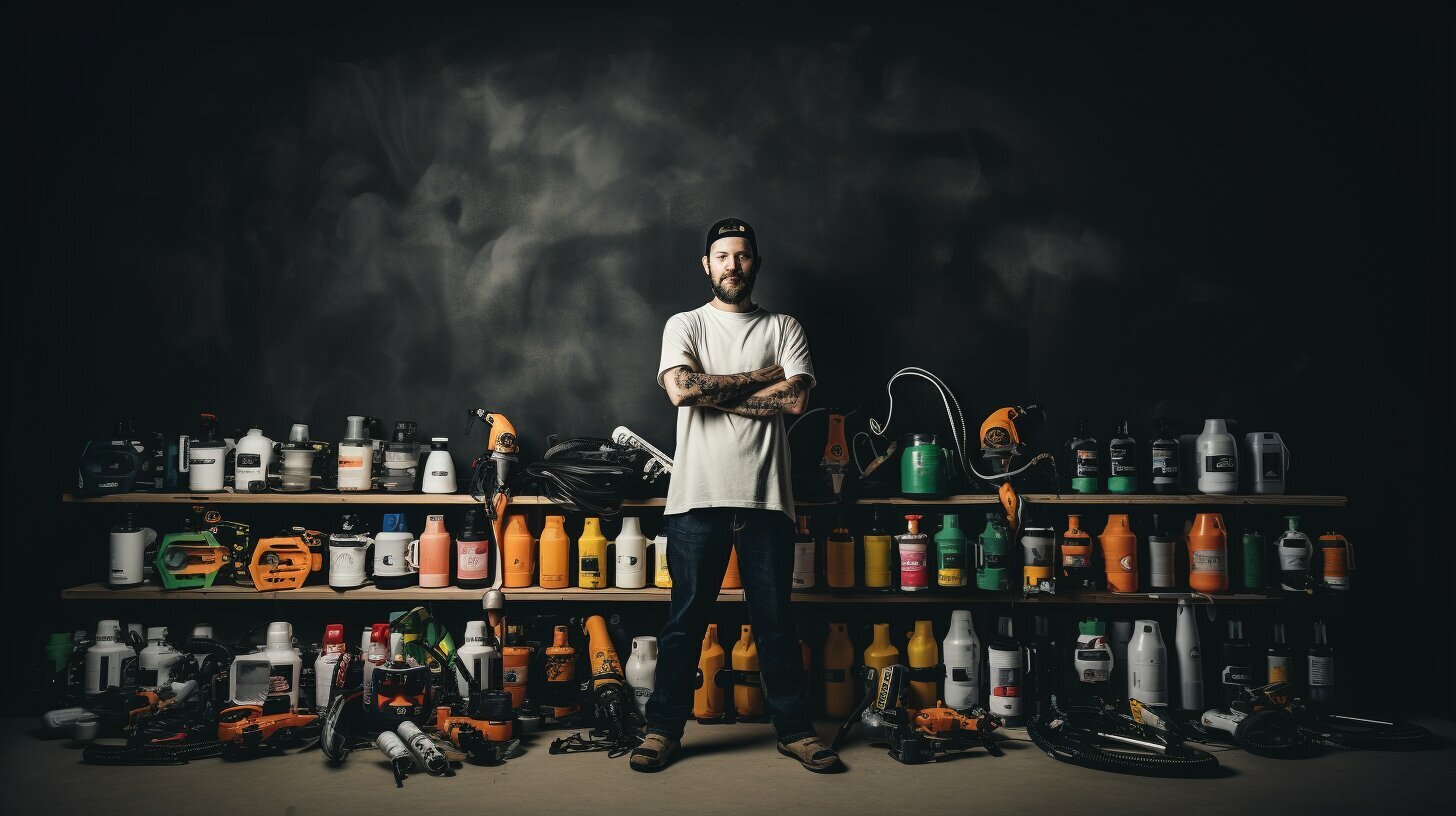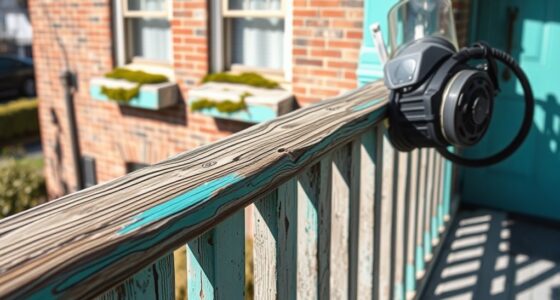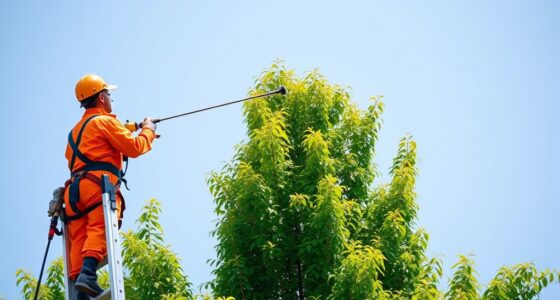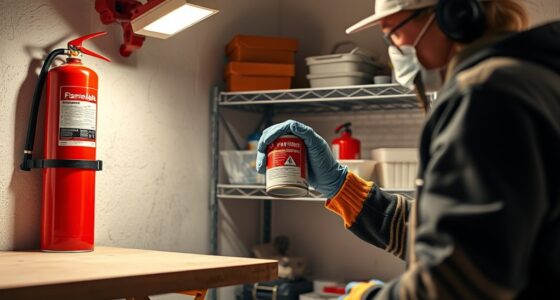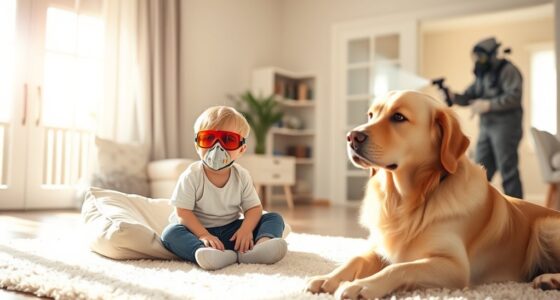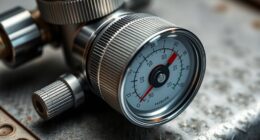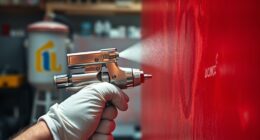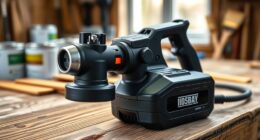Are you ready to step up your painting projects? Airless paint sprayers will transform the way you achieve professional-quality results quickly.
But before you dive headfirst into this efficient and convenient method of painting, it’s crucial to prioritize safety. In this comprehensive guide, we’ll walk you through everything you need to know about airless paint sprayer safety.
From understanding the basics of these powerful tools to implementing essential tips for accident prevention, we’ve got you covered. So grab your protective gear and let’s ensure that your painting experience is not only effective but also safe!
Understanding the Basics of Airless Paint Sprayer Safety
What is an airless paint sprayer? It’s a powerful tool that uses high pressure to atomize paint, delivering a smooth and even finish. Unlike traditional paint brushes or rollers, airless sprayers can cover large surfaces in no time. However, with great power comes great responsibility, as these machines also come with potential safety hazards.
One of the primary safety risks associated with airless paint sprayers is the risk of injection injuries. The high-pressure stream of paint can penetrate the skin if it comes into contact with your body. This makes it crucial to always wear protective clothing, including gloves and goggles, to minimize the risk of injury.
Another important aspect of airless paint sprayer safety is proper ventilation. Paint fumes can be harmful if inhaled for an extended period. Ensure that you are working in a well-ventilated area or use additional ventilation equipment like fans or exhaust systems to remove any potentially toxic fumes from the workspace.
Fire risks are also something to consider when using an airless paint sprayer. The flammable nature of some paints combined with electrical components can create a dangerous situation if not handled properly. Always keep flammable materials away from ignition sources and avoid spraying near open flames or sparks.
Remember, understanding the basics of airless paint sprayer safety is essential before embarking on any painting project. By being aware of potential hazards and taking necessary precautions like wearing protective gear, ensuring sufficient ventilation, and minimizing fire risks, you’ll be able to enjoy all the benefits this efficient tool has to offer without compromising your safety.
What is an Airless Paint Sprayer?
An airless paint sprayer is a powerful tool commonly used in the painting industry. Unlike traditional paintbrushes or rollers, which rely on manual effort to apply paint, an airless sprayer uses hydraulic pressure to atomize and propel the paint onto surfaces.
The basic components of an airless paint sprayer include a motor, pump, hose, and spray gun. The motor drives the pump, creating high-pressure fluid that is then forced through the hose and out of the spray gun’s nozzle. This process ensures even coverage and faster application compared to other methods.
One key advantage of using an airless sprayer is its ability to handle various types of paints, including latex-based paints and thicker coatings like enamels or primers. Additionally, it allows for precise control over the spray pattern and flow rate, making it suitable for both small-scale projects and large-scale applications.
However, it’s important to note that while airless paint sprayers are efficient tools for achieving professional-looking results quickly, they also come with potential safety hazards. Understanding these hazards and taking proper precautions is crucial for ensuring a safe working environment when using an airless paint sprayer.
Potential Safety Hazards
Potential Safety Hazards
When it comes to using an airless paint sprayer, there are a few potential safety hazards that you need to be aware of. These hazards can arise if proper precautions are not taken while operating the sprayer.
One major hazard is the risk of fire and explosions. Since airless paint sprayers work at high pressure, any flammable materials or sparks in the vicinity can ignite and cause a fire or explosion. It’s important to keep all sources of ignition away from the spraying area and ensure good ventilation to prevent the accumulation of flammable vapors.
Another potential hazard is the injection of spray material into your body. The high-pressure stream produced by an airless paint sprayer can penetrate skin and underlying tissues, leading to serious injuries. That’s why it’s crucial to never point the gun at yourself or others and always wear protective clothing like gloves, goggles, and a face mask.
Leaks in the equipment are also a common safety concern. If there are any leaks in hoses, connections, or seals, they can result in accidental contact with hazardous chemicals or create slippery surfaces that increase the risk of falls. Regularly inspecting your equipment for leaks and promptly addressing them will help minimize these risks.
Inadequate ventilation is another hazard associated with airless paint sprayers. Paint fumes contain harmful chemicals that can lead to respiratory issues when breathed in for extended periods without proper airflow. To avoid this danger, make sure you have sufficient ventilation in your workspace by opening windows or using fans.
By being aware of these potential safety hazards and taking necessary precautions such as wearing protective gear, maintaining equipment integrity, ensuring proper ventilation, you can safely operate an airless paint sprayer without compromising your wellbeing. Stay tuned for our next section on essential tips for ensuring airless paint sprayer safety!
Necessary Safety Precautions
Necessary Safety Precautions
When it comes to using an airless paint sprayer, safety should always be a top priority. To ensure a safe and accident-free experience, there are several necessary precautions you should take.
Before starting any painting job, make sure to thoroughly read the instruction manual provided by the manufacturer. This will give you valuable information on proper usage and safety guidelines specific to your particular model.
Always wear appropriate protective clothing when operating an airless paint sprayer. This includes goggles or a face shield to protect your eyes from paint particles and vapors, as well as gloves and coveralls to shield your skin from potential chemical exposure.
Additionally, it is essential to ensure sufficient ventilation in the area where you will be spraying. Open windows or use fans if necessary to prevent the buildup of fumes that could be hazardous to your health.
Never underestimate the importance of having a fire extinguisher readily available in case of emergencies. Accidents can happen unexpectedly, so being prepared is crucial for ensuring your safety as well as protecting your property.
By following these necessary safety precautions with an airless paint sprayer, you can minimize risks and enjoy worry-free painting projects. Remember: safety first!
12 Essential Tips for Ensuring Airless Paint Sprayer Safety
Protecting Your Property
When using an airless paint sprayer, it’s essential to take precautions to protect your property. Cover nearby surfaces and objects with drop cloths or plastic sheets to prevent any accidental overspray. This will ensure that you maintain a clean and professional finish without causing damage or staining on unintended areas.
Wearing Protective Clothing
Safety should always be a priority when operating an airless paint sprayer. Make sure to wear appropriate protective clothing such as goggles, gloves, and a respirator mask. These items will shield you from potential hazards like airborne particles or fumes that may be emitted during the painting process.
Ensuring Sufficient Ventilation
Proper ventilation is crucial when using an airless paint sprayer. Ensure that the area where you are working has adequate airflow by opening windows and doors or utilizing fans or exhaust systems. Good ventilation helps to minimize the inhalation of harmful fumes and improves overall air quality.
Minimizing Fire Risks
Paints and solvents used in spray painting can be highly flammable. To reduce the risk of fires, keep away any open flames, sparks, cigarettes, or other sources of ignition from your work area. It is also important to store paints and solvents in a cool place away from heat sources.
Remember: these are just a few tips for ensuring airless paint sprayer safety! Stay tuned for more valuable information on how to use this powerful tool responsibly while achieving excellent results!
Protecting Your Property
When it comes to using an airless paint sprayer, one of the top priorities is protecting your property. After all, you don’t want stray paint splatters or overspray ruining your floors, furniture, or outdoor surfaces. Here are a few tips to help safeguard your property during the painting process.
Preparation is key. Before you start spraying, cover any items that cannot be moved out of the area with drop cloths or plastic sheets. This includes furniture, fixtures, and flooring. By taking this simple precautionary measure, you can prevent accidental damage caused by stray droplets of paint.
Consider creating a barrier around the area you’ll be painting in. You can use masking tape along baseboards and door frames to protect them from accidental contact with the spray gun. Additionally, applying painter’s tape on windows and glass surfaces will ensure they remain clean and free from unwanted paint marks.
If you’re working on an outdoor project such as painting fences or walls near vegetation or delicate structures like flower beds or statues; make sure to cover plants and other vulnerable items with tarps or plastic covers before starting the spraying process.
Lastly but importantly , always take care when maneuvering around corners and edges so that no unintentional drips occur onto adjacent surfaces.
By following these precautions for protecting your property while using an airless paint sprayer ,you can maintain a clean work environment while also preventing any costly mishaps that could damage your valuable belongings! So go ahead – get started on your next painting project confidently knowing that both quality workmanship AND protection for what matters most are within reach!
Wearing Protective Clothing
Wearing Protective Clothing is an essential safety measure when using an airless paint sprayer. It helps to minimize the risk of exposure to harmful chemicals and materials, as well as potential accidents or injuries. Here are some key points to consider when it comes to wearing protective clothing.
Always wear a long-sleeved shirt and pants made from durable materials such as cotton or denim. These fabrics provide an extra layer of protection against splatters and spills.
Don’t forget about your hands! Use gloves that are resistant to chemicals and have a good grip. This will not only protect your skin but also enhance your control over the sprayer.
Cover your feet with closed-toe shoes or boots that have slip-resistant soles. This will prevent any accidental slips or trips on wet surfaces while painting.
Never underestimate the importance of eye protection. Wear safety goggles or glasses with side shields to shield your eyes from overspray and potential debris.
Remember, wearing proper protective clothing can greatly reduce the risk of accidents and ensure a safe working environment while using an airless paint sprayer.
Ensuring Sufficient Ventilation
Ensuring Sufficient Ventilation is crucial when using an airless paint sprayer. Proper ventilation helps to prevent the build-up of toxic fumes and ensures a safe working environment. Here are some important tips to ensure sufficient ventilation while using an airless paint sprayer.
Always work in well-ventilated areas such as open spaces or rooms with windows and doors that can be opened. This allows fresh air to circulate and removes any hazardous fumes from the painting process.
Consider using fans or ventilators to enhance airflow in the workspace. Positioning them strategically can help dissipate any lingering fumes and maintain a constant flow of fresh air during painting.
If working indoors, it is essential to use exhaust systems or portable extraction units specifically designed for removing airborne particles and vapors generated by paint spraying. These devices effectively capture and filter out harmful substances before they have a chance to accumulate.
Make sure that your spray booth or containment area meets safety standards for proper ventilation. Such facilities should have adequate exhaust systems installed to remove overspray and ventilate the space efficiently.
By following these guidelines for ensuring sufficient ventilation, you can significantly reduce the risk of inhaling dangerous chemicals and create a safer environment while operating an airless paint sprayer.
Minimizing Fire Risks
When using an airless paint sprayer, it’s crucial to take proactive measures to minimize the risk of fires. The high-pressure equipment and flammable materials involved can be a recipe for disaster if not handled properly.
First and foremost, always ensure that your workspace is free from any potential fire hazards. Remove any combustible materials or sources of ignition from the area before you start painting. This could include items such as open flames, sparks, or hot surfaces.
Make sure to use non-flammable paint or solvents whenever possible. If you must use flammable materials, exercise extreme caution and follow all safety guidelines provided by the manufacturer.
Furthermore, keep a fire extinguisher nearby at all times while operating an airless paint sprayer. Familiarize yourself with its proper usage and ensure it is in good working condition before starting your project.
Never smoke or allow others to smoke near the spray area. Even a small spark can ignite flammable vapors and lead to a dangerous situation.
By taking these simple yet essential steps to minimize fire risks when using an airless paint sprayer, you can create a safer environment for yourself and those around you. Safety should always be the top priority when undertaking any painting project!
Proper Handling and Gun Orientation
Proper handling and gun orientation are crucial aspects of airless paint sprayer safety. When using an airless paint sprayer, it is important to hold the gun securely with both hands and maintain a firm grip. This will help you have better control over the spray pattern and reduce the risk of accidents.
Additionally, pay attention to your gun orientation while spraying. Keep the gun pointed away from yourself and others at all times. Avoid pointing the gun towards any body parts or surfaces that you don’t intend to paint. Maintaining the correct angle while spraying can also ensure even coverage and prevent overspray.
It’s essential to keep in mind that painting at too high or too low pressure can lead to uneven application and potential spray material wastage. Adjusting the pressure settings according to your project requirements is vital for achieving optimal results while maintaining safety standards.
Always follow manufacturer guidelines when it comes to cleaning out clogs or blockages in the spray tip or nozzle. Never use your fingers or any sharp objects directly on these components as they may cause injury or damage them permanently.
Remember, proper handling techniques and gun orientation not only contribute to a safer working environment but also play a significant role in achieving professional-quality finishes without compromising efficiency!
Utilizing Tip Guards
One important safety precaution when using an airless paint sprayer is to utilize tip guards. These small accessories may seem insignificant, but they play a crucial role in preventing accidents and ensuring your safety.
Tip guards act as a barrier between the spray tip and any objects or surfaces you don’t want to be painted. They help control the direction of the paint spray and prevent accidental overspray onto nearby furniture, walls, or other items. By keeping the paint confined to your intended target area, you can avoid unnecessary cleanup and potential damage.
Tip guards also provide protection against injuries caused by accidentally coming into contact with the high-pressure stream of paint. The guard acts as a shield that deflects any stray sprays away from your body or face. This protective measure reduces the risk of eye irritation, skin burns, or inhalation of harmful fumes.
Proper installation and maintenance of tip guards are essential for their effective use. Inspect them regularly for any signs of wear or damage and replace them promptly if needed. Additionally, make sure to clean them thoroughly after each use to prevent clogs that could affect spray pattern accuracy.
Remember that utilizing tip guards is not only about personal safety but also about protecting your work environment and those around you from potential accidents. So always ensure these simple yet vital accessories are properly installed before starting any painting project with an airless paint sprayer!
Dealing with Leaks
Dealing with leaks is an important aspect of airless paint sprayer safety. Leaks can not only lead to wasted paint, but they can also create a messy work environment and potentially cause accidents. Here are some tips for effectively dealing with leaks.
It’s crucial to regularly inspect your equipment for any signs of leaks before starting a painting job. Check the hoses, fittings, and connections thoroughly to ensure everything is tightly secured. If you notice any leaks or loose parts, address them immediately before proceeding.
If you encounter a leak during operation, stop spraying immediately and take necessary precautions. Turn off the sprayer and release pressure from the system by triggering the gun into an appropriate container or waste receptacle.
Identify the source of the leak and determine whether it requires a simple adjustment or replacement part. Depending on the severity of the leak, you may need to tighten or replace seals or gaskets.
Always keep spare parts handy in case of emergencies. Having extra seals and gaskets readily available will allow you to quickly fix minor leaks without disrupting your workflow.
By following these steps and promptly addressing any leaks that occur while using an airless paint sprayer ensures both efficiency in your painting tasks as well as maintaining a safe working environment.
Regular Maintenance and Cleaning
Regular maintenance and cleaning are crucial aspects of airless paint sprayer safety. By properly maintaining your equipment, you can ensure its longevity and efficiency while reducing the risk of accidents or malfunctions.
Regularly inspect all parts of the sprayer for any signs of wear or damage. This includes checking the hoses, filters, nozzles, and gun components. Replace any worn-out or damaged parts immediately to prevent potential issues during operation.
Clean the sprayer thoroughly after each use to remove any leftover paint residue. This will help prevent clogs and blockages that could affect the spray pattern or cause uneven application. Use appropriate cleaning solutions recommended by the manufacturer for optimal results.
Additionally, pay attention to proper storage practices for your airless paint sprayer. Store it in a dry and secure location away from extreme temperatures or direct sunlight. Proper storage will not only protect your equipment but also minimize any potential risks associated with accidents or unauthorized access.
Consider scheduling regular professional maintenance checks for your airless paint sprayer. Certified technicians can identify any underlying issues that may go unnoticed during routine inspections and provide necessary repairs or adjustments as needed.
Remember, regular maintenance and cleaning are essential habits to develop when using an airless paint sprayer safely and effectively!
Safely Storing the Sprayer
Safely Storing the Sprayer: When it comes to airless paint sprayer safety, proper storage is crucial. After all, you don’t want any accidents or mishaps when the sprayer is not in use. Here are a few essential tips to ensure that your sprayer is safely stored.
First and foremost, make sure to clean the sprayer thoroughly after each use. This includes flushing out any remaining paint from the system and properly cleaning all parts of the machine. By doing this, you prevent any clogs or blockages that may occur due to dried paint residue.
Next, find a secure location for storing your airless paint sprayer. It’s best to keep it in a cool and dry area away from direct sunlight or extreme temperatures. Additionally, consider using covers or protective cases specifically designed for airless paint sprayers to shield them from dust and debris.
Organizing your workspace also plays a role in safe storage practices. Keep your sprayer on designated shelves or hooks where it won’t be knocked over accidentally. And remember to store any flammable materials away from the spray gun area to minimize fire risks.
By following these guidelines for safely storing your airless paint sprayer, you can extend its lifespan while ensuring that it remains in optimal condition for future painting projects!
Organizing a Clear Workspace
When it comes to airless paint sprayer safety, organizing a clear workspace is crucial. A cluttered area can lead to accidents and injuries, making it essential to maintain a clean and organized environment.
Ensure that your work area is free from any tripping hazards such as cords or tools lying around. Use cable management solutions or tape down loose cables to prevent accidents.
Arrange your materials in an orderly manner. Keep paint cans closed when not in use and store them away from the spraying area. Have a designated space for brushes, rollers, and other equipment so they are easily accessible but out of the way.
Next, clear any obstructions that may hinder your movement while operating the sprayer. Remove furniture or cover it up with protective plastic sheets if necessary. This will allow you to move freely without risking accidental contact with objects.
Make sure there is adequate lighting in your workspace. Good visibility is essential for accurate spraying and avoiding potential hazards. Consider using additional lighting sources such as task lights or portable spotlights if needed.
By organizing a clear workspace before starting any painting project with an airless paint sprayer, you can significantly reduce the risk of accidents and create a safer working environment for yourself and others involved.
Recognizing Warning Signs
When it comes to airless paint sprayer safety, being able to recognize warning signs is crucial. These signs can indicate potential issues or malfunctions that could lead to accidents if left unaddressed. By staying vigilant and attentive, you can protect yourself and others from harm.
One important warning sign to watch out for is unusual noises coming from the sprayer. If you hear grinding, rattling, or any other unfamiliar sounds, it could be a sign of mechanical problems that need immediate attention.
Another red flag to be aware of is excessive vibration while using the sprayer. This could indicate an issue with the motor or pump and should not be ignored.
Additionally, pay attention to any changes in spray pattern or pressure inconsistency. If you notice sudden fluctuations in these aspects while painting, it may signify clogged filters or worn-out parts that require maintenance.
Keep an eye out for leaks or drips around the gun and hose connections. Even small leaks can escalate into bigger problems if not addressed promptly.
By recognizing these warning signs early on, you can take proactive measures to prevent accidents and ensure a safer working environment when using your airless paint sprayer. Stay alert and address any concerns immediately before they escalate into more significant issues!
Seeking Professional Assistance
If you encounter any difficulties or uncertainties while using an airless paint sprayer, it is crucial to seek professional assistance. These powerful machines require proper knowledge and expertise to operate safely and effectively. Don’t hesitate to reach out to professionals who can provide guidance and support throughout your painting project.
Professional assistance ensures that you receive accurate information regarding the operation, maintenance, and safety precautions of airless paint sprayers. Experts can help troubleshoot any issues you may face during the spraying process, such as clogs or leaks. Their experience allows them to identify potential hazards that might go unnoticed by inexperienced users.
By seeking professional help when needed, you are taking a proactive approach towards ensuring your safety and achieving optimal results with your airless paint sprayer. Professionals have the necessary training and understanding of how these machines work, enabling them to offer valuable advice on technique and product selection.
Remember that even if you consider yourself knowledgeable about airless paint sprayers, there may be instances where consulting a professional is essential. It’s better to be safe than sorry when dealing with potentially dangerous equipment like an airless paint sprayer!
Unveiling Common Safety Hazards with Airless Paint Sprayers
When it comes to airless paint sprayers, it’s important to be aware of the potential safety hazards that can arise during their use. Understanding these risks and taking proactive measures can help ensure a safe painting experience.
One common hazard is the risk of fire and explosion. This can occur if flammable materials are used or if there are sparks or open flames nearby. It’s crucial to take precautions such as keeping the area clear of combustible materials and ensuring proper ventilation.
Another hazard is the potential injection of spray material into your skin. The high pressure from an airless paint sprayer can cause serious injury if the spray tip comes into contact with your body. Always wear protective clothing, including gloves, goggles, and a mask, to minimize this risk.
Leaks in the spray gun or hose can also pose a safety issue. Not only do leaks waste paint and create uneven coverage, but they can also lead to slips and falls due to slippery surfaces. Regularly inspecting your equipment for any signs of leakage and addressing them promptly is essential.
Improper handling and gun orientation can result in accidents or injuries. Always hold the sprayer firmly with both hands while operating it, pointing away from yourself or others. Following manufacturer guidelines on correct usage techniques will help prevent mishaps.
By being aware of these common safety hazards associated with airless paint sprayers and implementing preventive measures like using protective gear, checking for leaks regularly, maintaining proper gun orientation while spraying- you’ll ensure a safer painting process overall
1. Hazardous Materials: Airless paint sprayers use potentially hazardous materials, such as paints and solvents. These materials can cause serious health issues if inhaled or ingested. Ensure that these materials are kept in a secure location away from children and pets.
2. Improper Use: Improper use of an airless paint sprayer can lead to injury such as burns, eye irritation, inhalation of chemicals, and skin irritation. Always read the safety instructions and take necessary precautions when using an airless paint sprayer.
3. Fumes: Using an airless paint sprayer can create fumes that are both harmful to you and the environment. It is important to always wear a respirator when using one of these tools, as well as work in a well-ventilated area with a high-quality exhaust fan to disperse the fumes outside your workspace.
4. Electrical Shock: Airless paint sprayers often require plugging into an electrical outlet for power, so there is always a risk of electric shock if proper precautions are not taken. Do not use the sprayer near water or where it could come into contact with standing liquids; make sure all cords are in good condition; and never touch the sprayer if your hands are wet or damp.
Fire and Explosion Risks
One of the most significant safety hazards associated with airless paint sprayers is the risk of fire and explosion. This can occur due to various reasons, such as electrical malfunctions or sparks igniting flammable materials. The high-pressure nature of these sprayers also increases the chances of ignition.
To minimize these risks, it’s crucial to follow proper safety protocols. Ensure that your work area is free from any flammable substances or sources of ignition. Keep a fire extinguisher nearby at all times in case of emergencies.
Regularly inspect your equipment for any damaged wires or faulty connections that could potentially cause sparks. Proper grounding is essential to prevent static electricity buildup and potential fires.
Use non-flammable paint solvents and materials when operating an airless paint sprayer. Avoid using aerosol cans near the spraying area as they are highly combustible.
Be cautious when refueling the sprayer or handling fuel containers. Always do so in a well-ventilated space away from open flames or heat sources.
By being proactive and taking necessary precautions, you can significantly reduce the risks associated with fire and explosions while using an airless paint sprayer.
Potential Injection of Spray Material
Potential Injection of Spray Material
One of the potential safety hazards associated with airless paint sprayers is the risk of injection. This occurs when pressurized spray material comes into contact with the skin or enters the body through a puncture wound. The high pressure from these sprayers can force paint or other liquids deep into tissues, causing serious injuries.
To prevent this hazard, it is crucial to always wear appropriate personal protective equipment (PPE), such as gloves and coveralls, that offer a barrier against injected materials. Additionally, never point the spray gun at any part of your body or anyone else’s while operating the sprayer.
Furthermore, it is essential to inspect all hoses and connections regularly for any signs of wear or damage. A hose failure during operation could result in a sudden release of pressurized material. Always handle hoses carefully and avoid kinks or bends that may compromise their integrity.
Proper training on using an airless paint sprayer is vital to understanding how to minimize the risk of injection injuries. Knowing how to safely handle and operate the equipment will greatly reduce accidents and ensure your painting projects are completed without incident.
Remember, being aware of potential injection hazards and taking necessary precautions can help protect yourself and others while using airless paint sprayers. Stay safe by prioritizing safety measures every time you pick up your sprayer!
Proactive Measures to Prevent Accidents While Using Airless Paint Sprayers
Proactive Measures to Prevent Accidents While Using Airless Paint Sprayers
When it comes to using airless paint sprayers, taking proactive measures can go a long way in preventing accidents and ensuring your safety. Here are some essential tips to keep in mind:
1. Before starting any painting project, make sure to thoroughly read the instruction manual provided with your airless paint sprayer. Familiarize yourself with the proper operation and safety guidelines.
2. Always wear protective clothing, including goggles or a face shield, gloves, and coveralls. This will protect you from potential chemical splashes or overspray.
3. Adequate ventilation is crucial when working with paint sprayers indoors or in enclosed spaces. Open windows and doors, use fans or exhaust systems to ensure fresh air circulation.
4.Properly store flammable materials such as paints and solvents away from heat sources or open flames. Be cautious of sparks that could potentially ignite these substances.
Remember that accidents can happen even when precautions are taken seriously; therefore always be aware of your surroundings while using an airless paint sprayer.
Expert Assistance from HCC Airless for Paint Sprayer Safety
Expert Assistance from HCC Airless for Paint Sprayer Safety
When it comes to airless paint sprayer safety, it’s crucial to prioritize the well-being of yourself and those around you. By following the necessary precautions and implementing proactive measures, accidents can be significantly reduced.
However, if you still have concerns or questions about airless paint sprayer safety, don’t hesitate to reach out for expert assistance. At HCC Airless, we specialize in providing top-notch equipment and resources for a safe painting experience.
Our team of professionals is always ready to assist you with any queries or concerns regarding airless paint sprayers. Whether you need guidance on proper handling techniques, advice on maintenance practices, or information on choosing the right protective gear – we’ve got you covered.
By seeking expert assistance from HCC Airless, you can gain peace of mind knowing that your painting projects will be carried out safely and efficiently. Our knowledgeable staff is committed to ensuring your safety while using airless paint sprayers.
Remember that investing in quality equipment and relying on reliable experts is essential when it comes to ensuring a safe working environment. Don’t compromise on safety – choose HCC Airless for all your paint sprayer needs.
Stay safe!

